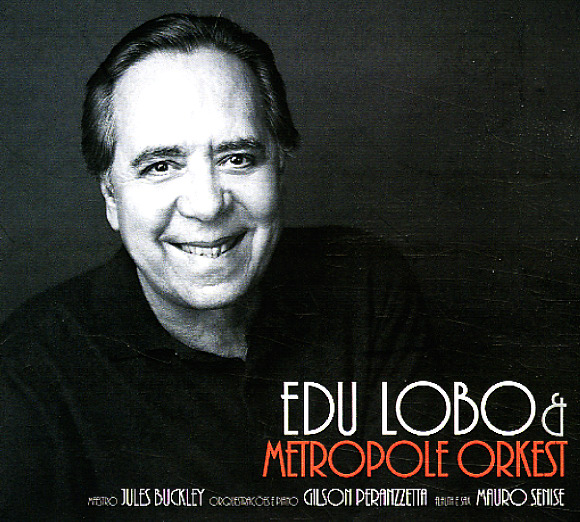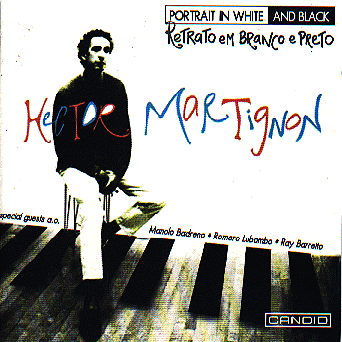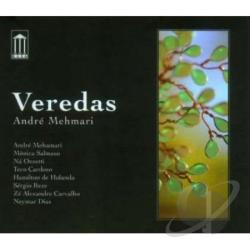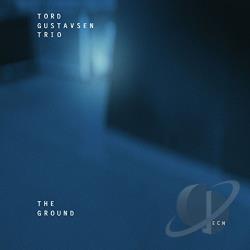Hiromi
Move: The Trio Project
 By Jeff Winbush
By Jeff Winbush
In a world where the path to commercial success is to play it safe and keep faith in formula, it is only within jazz where being unpredictable is not only a virtue, but an expectation. Hiromi marks her first decade of music-making on her terrific ninth album, Move featuring her Trio Project with bassist Anthony Jackson and drummer Simon Phillips.
Reunited with Jackson and Phillips for a second outing after 2011's superb Voice, (Telarc, 2011) the two veteran musicians provide the Japanese pianist with a rhythm section that can not only keep up with her but push her in a way she wasn't by her Sonicbloom band. That is not to disparage the talents of drummer Martin Valihora and bassist Tony Grey, but different players bring different dynamics to a band and in Jackson and Phillips rhythm section, Hiromi's mash-up of post-bop, straight-ahead and rock styles come together in a blistering tour de force.
The majority of Hiromi's recordings are built around a concept and on Move, it's "Time in one day." Think of it not as much of a sequel to Time Control (Telarc, 2007), which focused on a similar theme and featured the ecletic/electric guitar stylings of Dave Fiuczynski, but as an advancement of those themes with the soloing no longer between her piano and Fiuczynski's guitar as it is with Phillips' drums.
Phillips' background is rooted in rock (Toto, The Who, Judas Priest, David Gilmour) and he brings that attitude to his timekeeping, but that doesn't mean he can't swing. Phillips can make it sound pretty when the moment calls for it, but his ferocious approach does take some getting used to. There are traces of Tony Williams and Steve Gadd in the power displays of Phillips as he is given plenty of solo space and he doesn't squander it. Holding down the bass chores, Jackson is more traditional in his role than his partners, but they also serve those who sit back and go about their business with cool professionalism.
"Move" begins with the a note being repeated until Phillips and Jackson jump in and off we go for 8:34 as it twists and turns in a knotty, intricate and difficult composition. It's exhausting, but in the way a thrill ride at an amusement park is. The moments of power and glory are matched by quieter ones that are graceful and subtle such as "Brand New Day." That's what Move is: an audio aerobic work out with moments of kinetic, frenetic movement followed by time to cool down and cool out a bit. At times there wasn't enough of a blend between the two on Voice and Hiromi strikes a happy balance here.
The "Escapism" suite ("Reality," "Fantasy," "In Between") is the centerpiece of a nearly 70-minute recording. Everything that either impresses or infuriates Hiromi's fans and critics can be found here. As an artist with supreme confidence in herself, it's doubtful whether Hiromi herself gives much thought to how her compositions are received. Calling it jazz doesn't quite seem to fit, but calling it rock doesn't do it either.
One way to look at what Hiromi and company are doing is to equate what they're trying with another band they seemingly have little in common with. Take Rush, the Canadian power rock trio, and swap out Alex Liefson's guitar for Hiromi's piano, sub-in Phillips for drummer Neil Peart and ditch Geddy Lee's vocals but hand the bass duties to Jackson and the fundamentals are pretty much the same except now this is a power jazz trio.
Move operates on an entirely different level from Hiromi's previous releases. It is less exploratory, yet it never plays it safe and retains her highly developed sense of fun. Are there are moments when she needs to throttle back just a bit? Sure, as her synthesizer solos are more about sound effects than saying anything bold or particularly innovating, but carping on that is like griping Lebron James isn't as exciting executing a jump shot as a slam dunk. Even a fan will find moments where the wall of sound approach of Hiromi and co-producer Michael Bishop is a bit loud or showy for the sake of showmanship. That is part of what the Trio Project is about; combining complexity with technical brilliance, but never losing sight of the fun aspect. "One size fits all" doesn't work for socks and it sure doesn't apply here.
For those who've been along for the ride that began with the debut of Another Mind (Telarc, 2003) this represents an another incredibly inspired stop in Uehara's decade-long pursuit of innovation and excellence. Not everyone will understand or enjoy what she is trying to do, but those who punched their tickets a decade ago will likely consider Move an early contender for Album of the Year. It certainly belongs in the conversation of whatever albums are.
Track Listing:
Move: Brand New Day; Endeavor; Rainmaker; Suite Escapism: Reality; Suite Escapism: Fantasy; Suite Escapism; In Between; Margarita!; 11:49 PM
Personnel:
Hiromi Uehara: piano, keyboards; Anthony Jackson: contrabass guitar; Simon Phillips: drums
Aaron Diehl
The Bespoke Man's Narrative
 By Mark F. Turner
By Mark F. Turner
The reference to some exquisitely dressed man in the title of this release also conveys the stylistic bent of pianist Aaron Diehl's noteworthy debut on Mack Avenue. He is among a list of rising jazz pianists which include Gerald Clayton and Aaron Parks. The recording brings to life a project that was conceived in Indianapolis after Diehl, 26, earned first place in American Pianists Association's 2011 Cole Porter Fellowship.
The project fully displays Diehl's musicality—exquisite touch, phrasing, and melodicism and intricate compositions realized by equally gifted peers—the brilliant vibraphonist Warren Wolf and robust timing of drummer Rodney Green and bassist David Wong. The beginning bookend, "Prologue," sets the tone with a touch of finesse and groove, while the remaining tracks cover fresh originals and stirring arrangements of time weathered classics.
While firmly planted in the present, there's a timeless quality to the music, hearkening to the panache of pianist Duke Ellington and swing of The Modern Jazz Quartet. "Generation Y"'s fragile start gives way to boiling intensity as Wolf and Diehl soar with virtuosity. Yet it's also the sensual minor blues of "Blue Nude" that confounds the timeline as the cool melody floats lazily with vibraphone accents, Diehl's sophisticated playing, and Green's sweet drum spot.
Diehl's fingers enunciate each note and phrase on the poignant rendition of Ellington's "Single Petal of a Rose," paying respect to the original to a fault, down to Wong's bass accompaniment at the closing. This same deference is held for the Gershwin brothers' "Bess, You Is My Woman Now" and French composer Maurice Ravel's "Le Tombeau De Couperin (III. Forlane)," music that is skillfully and gorgeously rendered as the piano trio masterfully works through the changes. The attention to detail and high level of musicianship speak volumes of Diehl's savvy pianism in a release that not only possesses style but plenty of substance.
Track Listing:
Prologue; Generation Y; Blue Nude; Moonlight In Vermont; Single Petal Of A Rose;The Cylinder; Stop And Go; Le Tombeau De Couperin (III. Forlane); Bess, You Is My Woman Now; Epilogue;
Personnel:
Aaron Diehl: Rodney Green: drums; piano; Warren Wolf: vibes (1-4, 6, 7, 10); David Wong: bass.
Stanley Cowell
It's Time
 By Greg Simmons
By Greg Simmons
The durable piano trio, with bass and drums accompaniment, is one of the most frequently employed and time-tested combos in jazz. The competition is fierce to say anything new or noteworthy, with plenty of attempts that yield mixed results. So it's a great pleasure to hear Stanley Cowell's It's Time: a finely crafted collection of mostly originals that is at once sophisticated, both aggressive and pensive, and simply fascinating to listen to.
It's Time uses melody, rhythm, and space to construct music that can be in turns deceptively simple or jarringly complex—even cacophonous in places. Cowell has speed and dexterity, but employs them judiciously in the service of his compositions. On some tracks he falls back to quiet construction, following with a big vamp or explosive crescendos, but even at his most intense Cowell's playing has a certain delicacy to it. Every track has been clearly thought out, but they all still retain a sense of spontaneity, and regardless of whether Cowell is playing hard or soft, inside or outside, the record is exceptionally engaging. There is not one dull second on this date.
The accompanying bass and drums are fully integrated into the compositions, not there to merely keep time. On "El Space-O" drummer Chris Brown keeps a spare tick-tock rhythm that, while restrained, caries a subtle forward motion. He varies his impacts enough, altering among his drums and cymbals, to make it clear that he's contributing to the music instead of just supporting it. Cowell's melody is essentially a minor blues, although a very urbane interpretation. He uses the framework as a platform for improvisation that morphs from variations on the melodic chord structure into deconstructed sheets of sound, with waves of notes seemingly delivered with all ten fingers rolling the keys simultaneously. The intensity of his delivery is periodically at odds with the stately tempo, but in the end he recapitulates to bring it all home cleanly.
The title track, a Max Roach composition, opens with a hymn-like chord structure, even as the piece quickly breaks into a gallop. Cowell plays this one hard, densely packing his improvisations with long, tight runs, but regularly falling back into the chord sequence to ensure that he never strays too far. Perhaps most noteworthy: even as he races across the keys—and he is racing—his touch is always erudite and even light-handed. There's a remarkable grace and refinement in his playing.
In addition to great music, it's worth noting that the recording of It's Time is exceptional. Steeplechase albums have always been well recorded, but their digital media has sometimes lost something in translation. In the last few years they appear to have placed a new emphasis on delivering excellent sounding CDs and they're now really doing justice to their musicians.
If It's Time is an indication of the music kicking around in Cowell's head, he should go record more of it. It's Time is a first-rate performance that begs for an encore.
Track Listing:
Cosmology; El Space-O; Vishnu On The Serpent; Krishna; Asian Art Suite; Glass Ball & Couch Bed; Brawl Inducer; I Never Dreamed; It's Time; King; We Shall 2; Long Vamp; Abstrusions.
Personnel:
Stanley Cowell: piano; Tom DiCarlo: bass; Chris Brown: drums.
Edu Lobo & Metropole Orkest
 By DustyGroove
By DustyGroove
Some of the boldest, most expressive work we've heard from Edu Lobo in years – a beautiful recording with the Metropole Orchestra, who help Lobo regain all the lofty power of his early 70s years! The arrangements here are full, and full of feeling too – lead vocals by Lobo soaring over the top of his sublime compositions, pushed onward strongly with the full orchestrations of the ensemble –and given some great jazzy undercurrents by the flute and sax work of Mauro Senise! We always like Edu, but the album's a real return to the qualities that first made us fall in love with his music so many years ago – and is continuing proof that the Metropole Orchestra really know how to bring new energy to an artist. Titles include "Vento Bravo", "Canto Triste", "Casa Forte", "Zanzibar", "Ave Rara", "Choro Bandido", "A Bela E A Fera", "Frevo Diabo", and "Danca Do Corrupiao".
By O Fluminense
CD foi gravado em uma noite, no concerto realizado em 28 de maio de 2011, onde também tocaram os brasileiros Mauro Senise e Gilson Peranzzetta, fiéis companheiros de Edu.
Ter o privilégio de ter parte de sua obra revista com a luxuosa companhia da Metropole Orkest (orquestra holandesa formada em 1945) é para poucos. Apenas alguns poucos nomes, como Al Jarreau, Herbie Hancock, Ivan Lins e Egberto Gismonti.
Agora chegou a vez do registro do encontro entre Edu Lobo e a Metropole chegar ao mercado.
Edu Lobo & Metropole Orkest (Biscoito Fino) foi gravado em uma noite, no concerto realizado em 28 de maio de 2011, onde também tocaram os brasileiros Mauro Senise e Gilson Peranzzetta, fiéis companheiros de Edu.
Regida pelo maestro Jules Buckey e com orquestrações de Peranzzetta, o concerto recria algumas das mais belas canções da autoria de Edu, com parceiros como Aldir Blanc (Ave Rara), Chico Buarque (A Bela e a Fera, Na Carreira e Choro Bandido), Vinícius de Moraes (Canção do Amanhecer) e Paulo Cesar Pinheiro (Vento Bravo), além de algumas composições próprias.
O resultado dá outra dimensão ao trabalho de Edu, que se sai bem como intérprete, embora não seja essa a sua faceta mais conhecida ou de melhor resultado. O som envolvente da orquestra é mais que suficiente para recomendar esse CD. Isto, sem nem falar da beleza das composições do mestre Edu.
Dudu Lima
Cordas Mineiras
 By FarofaModerna Blog
By FarofaModerna Blog
Além da assinatura do seu trio, Dudu conta com a participação especial de um dos maiores nomes da música brasileira -- já consagrado internacionalmente, inclusive, como um dos grandes músicos brasileiros --, o compositor, guitarrista, cantor e arranjador mineiro Toninho Horta , além das participações de músicos convidados tais como Chico Curzio, Fofinho Forever, Hermanes Abreu, Juarez Moreira, Luis Leite e Salim; Dudu, por sua vez, atua no contrabaixo acústico, elétrico e fretless e em toda totalidade dos arranjos e da direção musical. Mas é preciso salientar, sobretudo, que acima do oportunismo, das boas intenções ou da própria necessidade de formar um público, a identificação do contrabaixista com o Clube da Esquina é eminentemente de origem nativa e apego cultural: ou seja, é natural que, sendo nascido em Juiz de Fora, Dudu represente suas origens mineiras através da sua arte de compor e do seu talento de interpretar. Contudo, muito mais do que atuar na função de intérprete, ele compõe sua própria música e recria as canções alheias bem ao seu estilo próprio de arranjo, sem transfigurá-las. Especificamente enquanto instrumentista, ele enfatiza o contrabaixo como o principal instrumento solista dentro da banda, colocando-o no centro em todas as linhas de frente: é muito interessante, por exemplo, como ele atua no suporte harmônico usando o contrabaixo elétrico como se este fosse um violão ou um piano, isso sem contar seus solos que são, ao mesmo tempo, virtuosos e líricos. Dentre as técnicas musicais utilizadas pode-se observar o "tapping", técnica ampliada pelo legendário guitarrista americano Stanley Jordan, amigo e constante parceiro de Dudu Lima.
Antecedido pelo magnifico projeto Ouro de Minas, também documentado em CD e DVD, o "Cordas Mineiras" apresenta nove canções, todas na linguagem instrumental: desse total, três delas, Benito (com participação especial deToninho Horta), Alma e Mr. Jordan (em homenagem a Stanley Jordan), são assinadas por Dudu Lima; as outras seis são Amor de Índio (Beto Guedes/ Ronaldo Bastos), Vento de Maio (Lô Borges/ Marcio Borges), Céu de Minas (Luiz Leite), Luar do Caçador (Chico Curzio), Baião Barroco (Juarez Moreira) e Trenzinho do Caipira (Heitor Villa-Lobos). Já em Ouro de Minas, Dudu Lima homenageou Fávio Venturini e, principalmente, Milton Nascimento e João Bosco, os quais também participam como colaboradores: de Venturini foi inclusa "Nascente"; de Bosco foram inclusas as canções "Corsário", "Bala com Bala" e "O Ronco da Cuíca"; enquando de Nascimento foram inclusas "Um Cafuné na cabeça, malandro, eu quero até de macaco", "Fé Cega", "Faca Amolada" e "Cravo e Canela". Enfim, como se pode presenciar, Dudu Lima, que já vinha de uma prolíficua carreira como contrabaixista, acaba por reafirmar seu talento nos meandros da composição e concretiza-se como um estudioso do inovador cancioneiro mineiro. Pois bem: o nosso desejo é que muitos álbuns e DVDS com belas composições próprias e/ou com belas releituras surjam. Como instrumentista, Dudu Lima já tocou com os mais diversos gênios da música brasileira e internacional: entre eles Stanley Jordan, Hermeto Pascoal, Jovino Santos Neto, Arthur Maia, Mauro Senise e Jean-Pierre Zanella.
Roberto Olzer Trio
Steppin´ Out
 By Roberto Olzer
By Roberto Olzer
‘Our Interest’s on the dangerous edge of things’: this phrase of the British novelist Graham Green came to mind the first time I played with Yuri and Mauro in 2008. It expresses that sense of vertigo which comes from making music without clinging to old, outworn paths but instead, reaching out to find a common, profoundly meaningful sound.
Sometimes, I am surprised, how well literary allusions are applicable to musical encounters and experiences. The same applies to the numerous remembrances of the poetry of Rilke which filled my thoughts these past months, as I prepared for this recording. There is a humble dedication to him in this work. In particular, the lyric, ‘Die Irren’ – the Madmen – recounts those nocturnal moments when their still faces appear at the windows of their prison and everything is in balance for a time: The garden, often distorted, is now soothed and grows to the pulsations of unknown worlds.
In other words: I think of music, this music, as something which brings a sense of meaning and harmony to my life. Far from being a useless ornament, it is an accomplishment– heralding the season of laughter and taking flight.
Roberto Olzer, pianoforte
Yuri Goloubev, contrabbasso
Mauro Beggio, batteria
Recorded and mixed on June 2012 at Artesuono (Udine), by Stefano Amerio.
Die Irren (to R. M. Rilke) (Roberto Olzer)
Pat’s World (Yuri Goloubev)
Filosofo (Elisa Marangon)
Gloomy Sunday (Rezso Seress)
Every little thing she does is magic (Sting)
Clay (Roberto Olzer)
Romanza (Francois Poulenc)
FF (Fast Forward) (Roberto Olzer)
Sad Simplicity (Yuri Goloubev)
The Edge (Roberto Olzer)





























